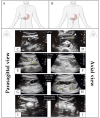Rapid Evaluation of Gastric Content With Ultrasound: An Educational Tool
- PMID: 38024067
- PMCID: PMC10657575
- DOI: 10.7759/cureus.49031
Rapid Evaluation of Gastric Content With Ultrasound: An Educational Tool
Abstract
Pulmonary aspiration is a severe complication in patients receiving anesthesia for surgical procedures. The risk and severity of aspiration are significantly higher in the presence of substantial gastric contents. Bedside ultrasound imaging of the gastric antrum is emerging as a rapid and valuable method to evaluate gastric contents before surgery. Rapid gastric ultrasound using a three-category grading system promotes timely decision-making to help in emergent or urgent surgeries by identifying patients with potentially high gastric volumes or solid food contents. In emergent cases with limited time, a single ultrasound view of the gastric antrum is still likely to yield helpful information. In this report, we argue that bedside ultrasound offers a more reliable assessment of gastric contents than assumptions based on time-based fasting guidelines.
Keywords: anesthesiology; aspiration risk; gastric content; gastric ultrasound; preoperative assessment; ultrasound.
Copyright © 2023, Nguyen et al.
Conflict of interest statement
The authors have declared that no competing interests exist.
Figures


References
-
- Flynn DN, Doyal A, Schoenherr JW. Treasure Island, FL: StatPearls Publishing; 2023. Gastric Ultrasound. - PubMed
-
- Meyer M, Previte J. Complications in Anesthesia (Second Edition) Vol. 2. Philadelphia, PA: W.B. Saunders Company; 2007. Perioperative aspiration pneumonitis; pp. 641–643.
-
- Aspiration under anaesthesia: risk assessment and decision-making. Robinson M, Davidson A. Contin Educ Anaesth Crit Care Pain. 2014;14:171–175.
-
- Gastroesophageal reflux and aspiration of gastric contents in anaesthetic practice. Ng A, Smith G. Anesth Analg. 2001;93:494–513. - PubMed
-
- Aspiration during anaesthesia in the first 4000 incidents reported to webAIRS. Kluger MT, Culwick MD, Moore MR, Merry AF. Anaesth Intensive Care. 2019;47:442–451. - PubMed
LinkOut - more resources
Full Text Sources
